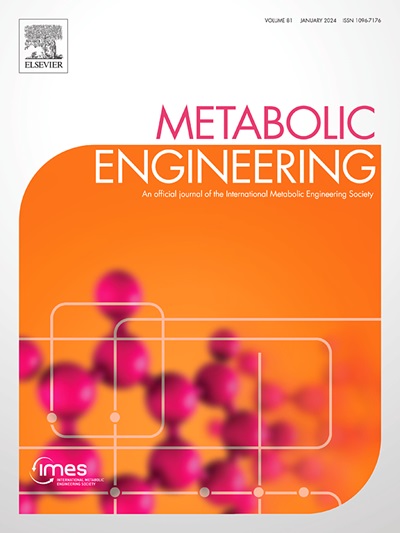改善挥发性脂肪酸分解代谢的裸冠突炎菌适应性实验室进化和代谢工程
IF 6.8
1区 生物学
Q1 BIOTECHNOLOGY & APPLIED MICROBIOLOGY
引用次数: 0
摘要
将大量废物流生物转化为高附加值产品,将成为不断发展的生物经济不可或缺的组成部分。挥发性脂肪酸(VFAs)(如丁酸盐、戊酸盐和己酸盐)是一种新兴的、前景广阔的废物衍生原料,可用于微生物碳升级再循环。裸冠突铜绿菌 H16 是将 VFAs 转化为各种生物产品的有利宿主,因为它具有多样化的碳代谢、易于进行代谢工程以及可用于工业规模。在这里,我们报告了一种提高 C. necator 产品滴度的常见策略--删除聚羟基丁酸(PHB)生物合成操作子--会导致 VFA 底物上的显著生长缺陷。通过适应性实验室进化,我们确定了调节基因 phaR、由 H16_A1372/H16_A1373 编码的双组分反应调节器-组氨酸激酶对以及由 H16_A2296-A2298 编码的三方转运体组件的突变是改善 VFA 底物生长的原因。缺失 phaR 和 H16_A1373 会导致 NADH 丰度显著降低,同时涉及碳代谢、电子载体平衡和氧化应激耐受性的基因表达也会发生巨大变化,这可能是这些工程菌株生长改善的原因。这些结果让我们深入了解了 PHB 生物合成在碳和能量代谢中的作用,并强调了调控因子 PhaR 在全球调控网络中的关键作用。通过组合突变,我们产生了对 VFAs 有显著生长改善的平台菌株,这能使废物衍生的 VFA 底物更好地转化为目标生物产品。本文章由计算机程序翻译,如有差异,请以英文原文为准。
Adaptive laboratory evolution and metabolic engineering of Cupriavidus necator for improved catabolism of volatile fatty acids
Bioconversion of high-volume waste streams into value-added products will be an integral component of the growing bioeconomy. Volatile fatty acids (VFAs) (e.g., butyrate, valerate, and hexanoate) are an emerging and promising waste-derived feedstock for microbial carbon upcycling. Cupriavidus necator H16 is a favorable host for conversion of VFAs into various bioproducts due to its diverse carbon metabolism, ease of metabolic engineering, and use at industrial scales. Here, we report that a common strategy to improve product titers in C. necator, deletion of the polyhydroxybutyrate (PHB) biosynthetic operon, results in a significant growth defect on VFA substrates. Using adaptive laboratory evolution, we identify mutations to the regulator gene phaR, the two-component response regulator-histidine kinase pair encoded by H16_A1372/H16_A1373, and the tripartite transporter assembly encoded by H16_A2296-A2298 as causative for improved growth on VFA substrates. Deletion of phaR and H16_A1373 led to significantly reduced NADH abundance accompanied by large changes to expression of genes involved in carbon metabolism, balance of electron carriers, and oxidative stress tolerance that may be responsible for improved growth of these engineered strains. These results provide insight into the role of PHB biosynthesis in carbon and energy metabolism and highlight a key role for the regulator PhaR in global regulatory networks. By combining mutations, we generated platform strains with significant growth improvements on VFAs, which can enable improved conversion of waste-derived VFA substrates to target bioproducts.
求助全文
通过发布文献求助,成功后即可免费获取论文全文。
去求助
来源期刊

Metabolic engineering
工程技术-生物工程与应用微生物
CiteScore
15.60
自引率
6.00%
发文量
140
审稿时长
44 days
期刊介绍:
Metabolic Engineering (MBE) is a journal that focuses on publishing original research papers on the directed modulation of metabolic pathways for metabolite overproduction or the enhancement of cellular properties. It welcomes papers that describe the engineering of native pathways and the synthesis of heterologous pathways to convert microorganisms into microbial cell factories. The journal covers experimental, computational, and modeling approaches for understanding metabolic pathways and manipulating them through genetic, media, or environmental means. Effective exploration of metabolic pathways necessitates the use of molecular biology and biochemistry methods, as well as engineering techniques for modeling and data analysis. MBE serves as a platform for interdisciplinary research in fields such as biochemistry, molecular biology, applied microbiology, cellular physiology, cellular nutrition in health and disease, and biochemical engineering. The journal publishes various types of papers, including original research papers and review papers. It is indexed and abstracted in databases such as Scopus, Embase, EMBiology, Current Contents - Life Sciences and Clinical Medicine, Science Citation Index, PubMed/Medline, CAS and Biotechnology Citation Index.
 求助内容:
求助内容: 应助结果提醒方式:
应助结果提醒方式:


